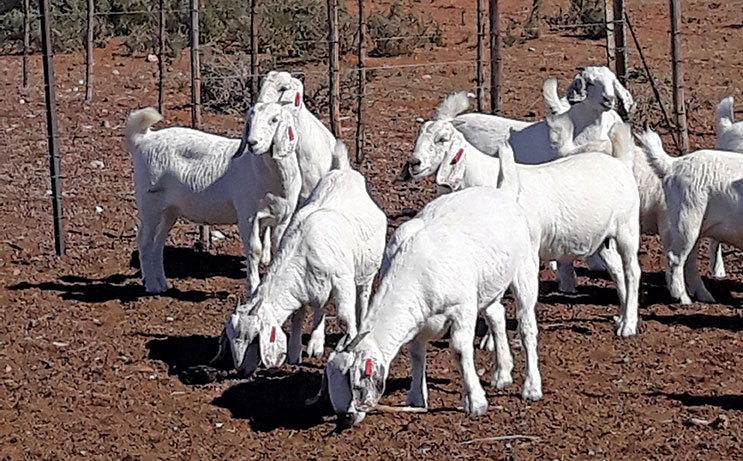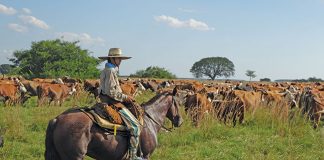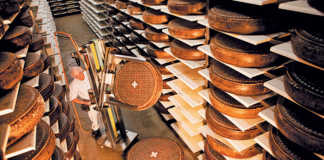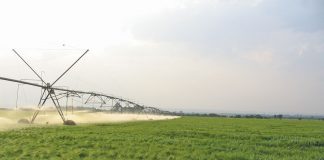
Photo: Annelie Coleman
After a gruelling 80km gravel road to Koenie Kotzé’s farm in the Niekerkshoop district, it’s a relief to reach the homestead, where he has especially kraaled his Savanna goats for Farmer’s Weekly’s visit.
This part of the Northern Cape, with its sparse vegetation, koppies and earthy colours, has a beauty of its own, and the Savannas stand out like white flowers against the stark background.
READ A successful Boer goat stud in the Hantam Karoo
The lively disposition of the Savannas is beautiful to behold. Even the adult animals climb into the feed troughs, stand upright against the kraal fences and climb on top of one other.
Despite this, the animals are not wild and have an even temperament.
Kotzé’s career as a breeder started in the 1980s when he became stud manager of the DSU Cilliers and Sons Savanna Stud. He recalls that although he was highly impressed with the qualities of the Savannas, he did not have enough money to start his own flock.
Cilliers and Sons along the Vaal River in Douglas started developing the breed in the 1950s, and are regarded as the pioneer Savanna breeders in South Africa.
Kotzé then went into an agreement with his employer to purchase some of the females with folded ears that they had wanted to cull. He also bought animals from other breeders.
“I selected top-class genetics despite the folded ears and so started the upbreeding of my own stud.”
Demand for white goats
The indigenous white Savanna goat breed, a truly South African breed, was developed from indigenous goats, as were the Boer and Kalahari Red goats.
According to Kotzé, one of the advantages of the Savanna is that its white is dominant over most other colours, and pure white goats are preferred for slaughtering at traditional ceremonies such as funerals and weddings.
Red-headed Boer goats are the next most popular breed.
“I get at least one phone call a week from KwaZulu-Natal about the availability of Savanna rams,” he says.
Consistently strict selection
Kotzé’s goats excel on the rugged veld of Niekerkshoop and Griekwastad, where rainfall varies widely and the temperature fluctuates from below freezing in winter to over 40°C in summer.
They have thick, pliable hides with short, white hair, and are resistant to heat and drought.
They are also fertile and easy to care for.
Kotzé selects ruthlessly for top reproduction, muscular development, good bones, and strong legs and hooves.
Although the goats have white hair, they are also selected for black pigmented hides, horns, hooves, eyelids and noses, and as little exposed hide as possible, to avoid skin cancer caused by the sun’s ultraviolet rays.
READ Vaccinate your animals; it’ll pay you in the long run
Teats and teat placement are two of the most important criteria in the selection of females; two functional teats are ideal. Kotzé also selects for well-formed and firmly attached udders.
For the rams, two reasonably large, well-formed, healthy and equal-sized testes are ideal. The scrotum must be at least 26cm in circumference, and a twisted scrotum is a cull defect.
Reproduction
According to Kotzé, reproduction forms the cornerstone of any livestock breeding enterprise, which is why it is crucial to select the top breeding animals. Multiple births are the norm. The ewes have a strong maternal instinct and excellent milk production.
Despite the recent harrowing drought, the Savannas have maintained a 150% lambing rate over the past five years.
Birthweight averages between 2,5kg and 4kg, and weaning weights are between 25kg and 35kg at four months. Under ideal conditions, the stud maintains a lambing rate of 180%.
Kotzé introduces new female genetics from the outside from time to time, but prefers to use his own rams. He made use of artificial insemination until nine years ago, but his rams were so virile that he stopped the practice.
The main breeding season falls between late summer and autumn.
No planted pastures
Kotzé farms on 6 000ha in the mountains near Niekerkshoop and Griekwastad. The goat stud is kept on 1 100ha, divided into six camps, each with its own watering point.
The soil varies from limestone to rocky in the mountainous areas. There are no planted pastures, and the stud is kept on sweetveld grazing all year round.
Savannas are indiscriminate grazers and browsers that utilise a wide range of vegetation, including trees, shrubs and grasses sometimes unpalatable to other farm animals.
According to Kotzé, the past nine years’ drought has resulted in the survival of the fittest.
“I sold my Kalahari Red stud to accommodate the 250-strong Savanna stud. This underscores the value of the breed for me,” he says.
Characteristics
Savannas are strong, medium-framed, functionally efficient animals. They move easily and can, if necessary, travel long distances in search of fodder and water. The ewes are aggressive and protect their kids fiercely.
Goats have a natural flocking instinct, and although black-backed jackal and caracal pose problems in the area, the Savannas’ aggressive protection of their young means that relatively few are lost to predation.
Stock theft does occur, unfortunately; Kotzé lost 43 ewes about four years ago to thieves.
The rams are masculine, robust and well-muscled.
Savannas have a fairly long, slightly curved head. The head and nose must be fairly broad and not sharp. The mouth must be reasonably wide, with muscled jaws.
“From the onset I’ve been extremely strict about eliminating cull faults such as undershot
jaws, knock knees, bandy legs, weak pasterns, and hoofs pointing outwards or inwards,” says Kotzé.
His passion for functionally correct and uniform animals has been rewarded with his goats taking the honours a number of times at world championships since 2003.
“At an agricultural show, my wife Marina and I were once asked if we’d succeeded in photocopying our animals because of their invariable uniformity and unbroken top quality.
This was a compliment indeed,” he says.
A passion beyond Savanna goats
Kotzé is a qualified judge and inspector of Savanna goats and Boer goats, as well as Van Rooy, Kalahari Red, Dorper, White Dorper and Persian sheep. He has been invited to judge all over the world, including Mexico, China, Australia, Brazil, the US, Namibia and Botswana.
“I’m passionate about breeding top animals of various breeds. This is why my farming concern also includes Bonsmara and Dexter herds. The rest of my business consists of Boer goats, Dorper, White Dorper and Van Rooy sheep, as well as three types of Persian sheep.
“I also breed four- and five-horned sheep to preserve their genetics,” Kotzé says.
His mentor and long-time friend, Theuns Botha, describes him as one of the best small- stock adjudicators in South Africa. Botha and Kotzé are the only two people qualified to adjudicate seven smallstock breeds in the country.
“Koenie is, in my opinion, by far the best Savanna goat breeder in South Africa. He produces top genetics that benefit commercial and stud breeders,” says Botha.
Phone Koenie Kotzé on 076 181 0710, or email him at [email protected].











